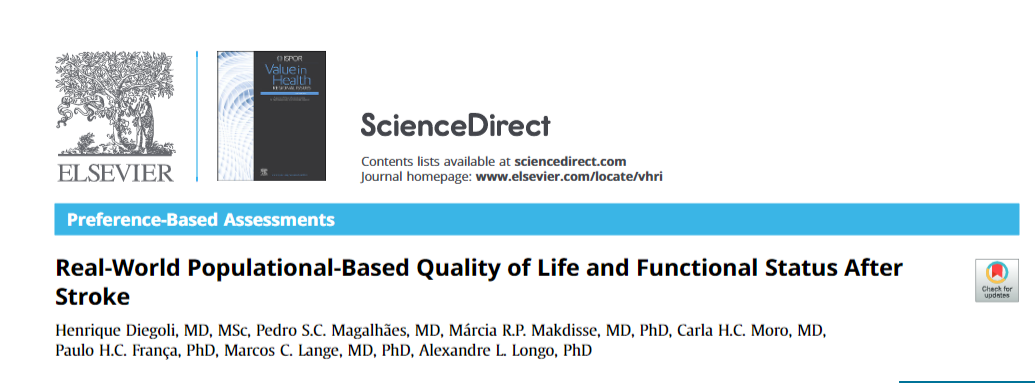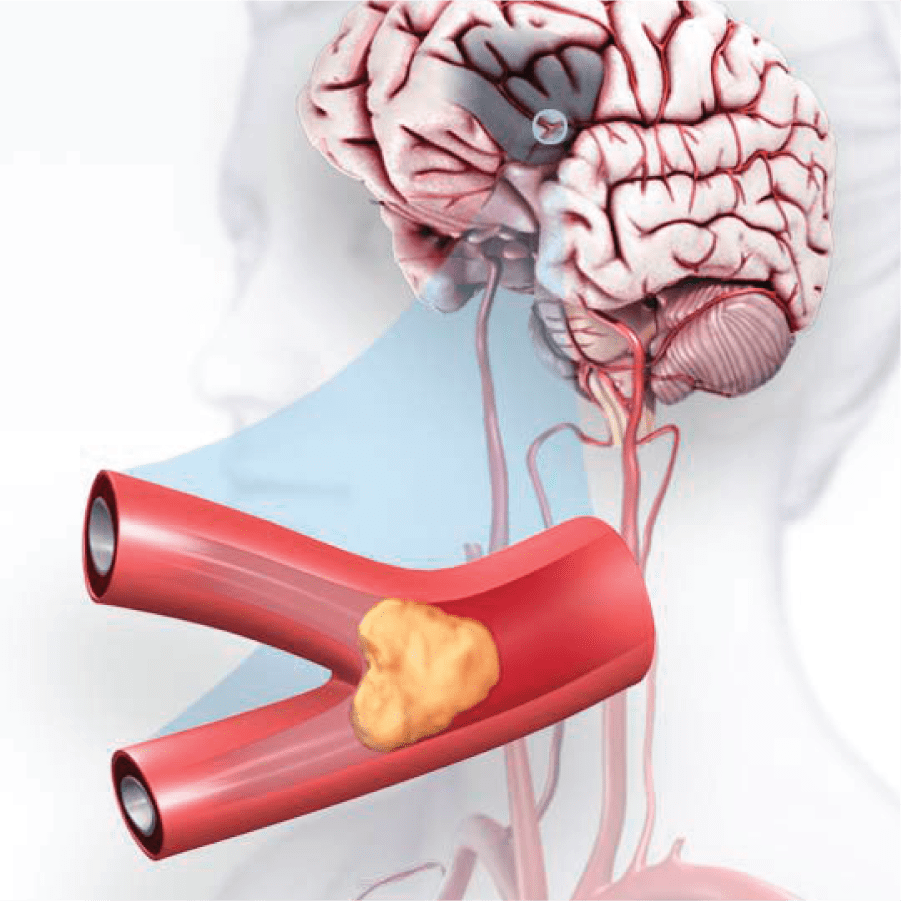the health strategist
institute of research and strategy
for continuous health transformation and digital health
Joaquim Cardoso MSc
Chief Researcher & Editor of the Site
April 11, 2023
ONE PAGE SUMMARY
This study aimed to describe the health-related quality of life (HRQoL) of Brazilian stroke patients and compare the HRQoL of functionally dependent and independent patients while identifying HRQoL predictors.
In Brazil, 1 in 5 stroke patients become severely disabled (modified Rankin scale [mRS] 3–5), requiring assistance with daily activities and negatively affecting health-related quality of life (HRQoL). 3,4
The study found that the HRQoL of functionally dependent patients was significantly lower than that of functionally independent patients.
The multivariate analysis showed that older age, sex, diabetes, and hypertension were associated with poor HRQoL.
The modified Rankin scale (mRS) was shown to be reliable for predicting poor HRQoL after stroke.
These findings will be helpful for calculating the utility after a stroke in Brazil and other Latin American countries, which is useful for investigating the cost-effectiveness of treatments that prevent stroke and treatments that reduce the severity of strokes.
DEEP DIVE

Highlights
- Health-related quality of life (HRQoL) utility after stroke is currently unknown in Brazil.
- Using population-based data, we found that the 1-year HRQoL after stroke is 0.71, significantly lower in dependent (0.40) than independent patients (0.81).
- These real-world findings are helpful for many future studies, such as those examining the burden of stroke and economic evaluations that include stroke as an outcome or seek to improve functional status after stroke.
- The study also confirms that the modified Rankin scale (mRS) is a reliable HRQoL surrogate and provides mapping scores to convert mRS to utility, which is helpful for stroke studies that include the mRS but not the EQ-5D.
ABSTRACT
Objectives
- This study aimed to describe health-related quality of life (HRQoL) 3 months and 1 year after stroke, compare HRQoL between dependent (modified Rankin scale [mRS] 3–5) and independent (mRS 0–2) patients, and identify factors predictive of poor HRQoL.
Methods
- Patients with a first or ischemic strokeintraparenchymal hemorrhage from the Joinville Stroke Registry were analyzed retrospectively.
- Using the 5-level version of the EuroQol-5D questionnaire, HRQoL was calculated for all patients 3 months and 1 year after stroke, stratified by mRS score (0–2 or 3–5).
- One-year HRQoL predictors were examined using univariate and multivariate analyses.
Results
- Three months after a stroke, data from 884 patients were analyzed; 72.8% were categorized as mRS 0–2 and 27.2% as mRS 3–5, and the mean HRQoL was 0.670 ± 0.256.
- At 1-year follow-up, 705 patients were evaluated; 75% were classified as mRS 0–2 and 25% as mRS 3–5, and the mean HRQoL was 0.71 ± 0.249.
- An increase in HRQoL was observed between 3 months and 1 year (mean difference 0.024, P < .0001), both in patients with 3-month mRS 0–2 (0.013, P = .027) and mRS 3–5 (0.052, P < .0001).
- Increasing age, female sex, hypertension, diabetes, and a high mRS were associated with poor HRQoL at 1 year.
Conclusions
- This study described the HRQoL after a stroke in a Brazilian population.
- This analysis shows that the mRS was highly associated with HRQoL after stroke.
- Age, sex, diabetes, and hypertension were also associated with HRQoL, although not independently of mRS.

Real-World Populational-Based Quality of Life and Functional Status After Stroke
Elsevier
Henrique Diegoli MD, MSc 1, Pedro S.C. Magalhães MD 1, Márcia R.P. Makdisse MD, PhD 1, Carla H.C. Moro MD 2, Paulo H.C. França PhD 3, Marcos C. Lange MD, PhD 4, Alexandre L. Longo PhD 2
July 2023
Introduction
Stroke is the second leading cause of death and the third leading cause of death and disability worldwide. 1Between 1990 and 2017, the crude incidence and prevalence of stroke increased by 81% and 95%, respectively, in Latin America, where access to stroke therapies and rehabilitation is limited. 2
In the aftermath of a stroke, a patient’s functional status varies based on the severity of the stroke and may also be affected by poststroke recovery treatments.
In Brazil, 1 in 5 stroke patients become severely disabled (modified Rankin scale [mRS] 3–5), requiring assistance with daily activities and negatively affecting health-related quality of life (HRQoL). 3,4
Methods for measuring HRQoL allow estimation of utilities from health states, which aids in decision making and resource allocation. 5,6In cases of severe stroke where the patient is unable to make care decisions, proxies can be better informed when making treatment decisions if they have a better understanding of the patient’s likely outcomes. 7
In Brazil, decisions about stroke care have relied on studies with patients from high-income countries,8, 9, 10 and it is uncertain whether these utility values represent Brazilian preferences.
This study’s primary objective is to characterize HRQoL 3 months and 1 year after stroke in a Brazilian patient population.
Secondary objectives are to compare HRQoL between functionally dependent (mRS 3–5) and independent (mRS 0–2) patients and to identify HRQoL-predicting characteristics.
Methods & Results
See the original publication (this is an excerpt version only)

Discussion
This is the first study to describe HRQoL utility values after a stroke in Brazilian patients, in addition to providing HRQoL by functional status and an analysis of HRQoL predictors. HRQoL after stroke was described in a population-based sample, showing significantly lower HRQoL in functionally dependent patients than functionally independent patients at 1 year. When stratified by functional dependence at 3 months, HRQoL significantly improved from 3 months to 1 year for both groups. In the univariate analysis, female sex, a lower socioeconomic status, diabetes, hypertension, and a low mRS predicted HRQoL. The multivariate analysis without mRS showed that older age, sex, diabetes, and hypertension were associated with a poor 1-year HRQoL. mRS at 3 months was shown to correlate and predict 1-year HRQoL.
This study suggests that mRS is reliable for predicting poor HRQoL after stroke.
Although the correlation between the mRS and HRQoL has been previously documented, these findings are helpful for calculating the utility after a stroke in Brazil and other Latin American countries, which is useful for investigating the cost-effectiveness of treatments that prevent stroke and treatments that reduce the severity of strokes.
When comparing changes in utility over time, a study in The Netherlands reported an average utility of 0.73 2 months after a stroke and 0.74 at 1 year.23 This was a higher utility than observed in our study at 3 months, but they did not notice an improvement at 1 year, as our findings suggest. Approximately one-third of patients in each group decreased, increased, or maintained their score, similar to the findings of this study. The authors also observed that female sex and discharge to a nursing home or geriatric rehabilitation were associated with lower utilities. An average of 0.74 utility was observed 6 months after stroke in a Norwegian study,24 and 0.72 at 6 months and 0.73 at 1 year in a United Kingdom study.25 Nevertheless, direct comparison across studies is of limited value because criteria for inclusion and sample characteristics may vary.
When assessing predictive factors of poor HRQoL, a 2022 study by Mei et al26 describes HRQoL after stroke in a Chinese setting (0.885 utility) with predictive factors of poor HRQoL including lower income, illiteracy, and diabetes. These were similar to the predictive factors found in this study — lower social class and diabetes. A major difference was the cross-sectional sample from a general population survey and investigating the prevalence of stroke cases instead of new stroke patients. This methodology may select patients with milder cases given that severe cases have a higher mortality rate immediately after a stroke.
Previous studies have mapped mRS into utility values. A World Health Organization Global Burden of Disease Project valued mRS states using the person trade-off method by asking 9 stroke experts to value mRS states into disability weights, ranging from 0 (normal) to 1 (dead).27 Resulting utilities ranged from 0.046 for mRS 0 to 0.944 for mRS 5. Rivero-Arias et al25 identified stroke patients in the Oxford Vascular Study and mapped mRS onto the EQ-5D using various models with utility ranging from 0.936 for mRS 0 to −0.054 for mRS 5.
Although mRS scores were highly predictive of utility values in the present study, insofar as lower mRS scores accurately predicted poor HRQoL scores and vice versa, not all studies attributed the same set of utility values to each mRS score, and the HRQoL relative to mRS may be valued differently in different cultures. This may change the interpretation of results of future studies investigating therapies that prevent stroke or reduce stroke severity.
Limitations include a loss of HRQoL information in patients who died before the 3-month assessment. These patients likely have had more severe strokes with lower functional status, probably reducing the average HRQoL estimate. Because data originated from a population-based study, the risk of selection bias has been substantially reduced. Although there was a strong correlation between higher mRS and lower HRQoL, the mRS is conceptually different from the HRQoL measured by the EQ-5D because it does not account for pain, discomfort, and anxiety or depression. Therefore, the mRS is not a good proxy for HRQoL for poststroke treatments that focus primarily on those dimensions.

Conclusions
- This study described HRQoL after a stroke in a Brazilian population and found that the mRS is a reliable tool for predicting HRQoL after stroke, an important finding for studies that apply mRS as an outcome of stroke therapies.
- Age, sex, diabetes, and hypertension also predicted HRQoL, but not independently from mRS.
- This finding of real-world, long-term estimates of HRQoL is helpful for studies investigating the burden of stroke, economic evaluations that include stroke as an outcome, or aim to improve functional status after stroke.
Acknowledgment
Editorial support was provided by Oscar Bolanos, of Medtronic, with minor input levels. The authors thank Caroline Kroll, PhD, for her critical review of the manuscript.
References
See the original publication
Originally published at https://www.sciencedirect.com.
About the authors & affiliations
Henrique Diegoli MD, MSc 1,
Pedro S.C. Magalhães MD 1,
Márcia R.P. Makdisse MD, PhD 1,
Carla H.C. Moro MD 2,
Paulo H.C. França PhD 3,
Marcos C. Lange MD, PhD 4,
Alexandre L. Longo PhD 2
1 Academia VBHC, São Paulo, SP, Brazil
2 Joinville Stroke Registry, City Hall of Joinville, Joinville, SC, Brazil
3 Post-Graduation Program in Health and Environment, University of the Region of Joinville, Joinville, SC, Brazil
4 Federal University of Paraná, Clinical Hospital, Curitiba, PR, Brazil








